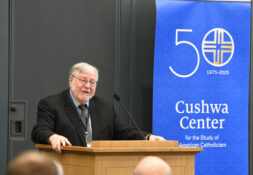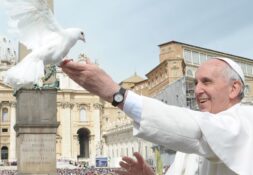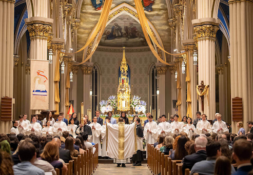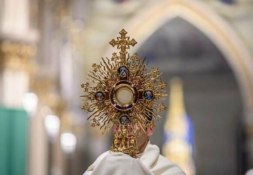“In the name of the Father, and of the Son, and of the Holy Spirit. Amen.”
Catholics rarely evoke the Trinity without tracing a Cross across their heads, sternums, left shoulders and right shoulders. They make the Sign of the Cross at dinner, at Mass, and often before bed, making the gesture seem integral to Catholic faith and practice. Despite being such a common gesture of prayer, the origins and full significance of the Sign of the Cross are not widely known. Where does it come from? What does it actually mean?
In a certain sense, the Sign of the Cross predates Christianity. According to Pope Emeritus Benedict XVI, ancient Jews would occasionally trace the last letter of the Hebrew alphabet, Tav, (“T” or “+” or “X”) on their foreheads as a sign of hope in God’s ownership and protection. This letter was referenced in Ezekiel when God says, “Go through the city, through Jerusalem, and put a mark upon the foreheads of the men who sigh and groan over all the abominations that are committed in it” (Ezekiel 9:4). In Ezekiel, the mark of the Tav was intended to set apart God’s faithful and to act as a sign of their fidelity to God’s laws during times of struggle.
Remarkably, there is little to no evidence that Christianity inherited the Sign of the Cross from the Jewish Tav. The Christian gesture more likely comes from Plato’s Timeaus. In this work, Plato describes a giant Chi (“+” or “X”) written upon the universe, which the early Church Fathers took as a sign that Christ’s death on the Cross was prefigured in the ordering of the cosmos. Saint Justin Martyr took this a step further by claiming that the symbolism of the Cross was inscribed in all things, including humanity. “For consider all the things in the world, whether without this form [the Cross] they could be administered or have any community … And the human form differs from that of the irrational animals in nothing else than in its being erect and having the hands extended … this shows no other form than that of the Cross” (I Apology 55).
Yet for early Christians, the Sign of the Cross was more than symbolic. Since antiquity, the Sign of the Cross has been seen as a vital part of sacramental practice. According to Saint Augustine, a baptism was not truly performed unless the minister made the holy gesture. Saint Chrysostom and Saint Cyril of Jerusalem both claimed that tracing the Sign of the Cross on one’s forehead invoked God’s protection, suggesting an early understanding of the Sign eerily similar to Ezekiel’s mark of the Tav.
While Christianity’s Sign of the Cross dates to at least the mid-second century (and possibly earlier), the manner of making the Sign of the Cross has evolved, adding layers to the sacred gesture’s meaning. Originally, a cross was traced on the forehead with either the thumb or the forefinger as a profession of Christian faith, an assertion of the cosmic scope of Christ’s sacrifice, and an invocation of God’s protection. During the early fifth century, Catholics began to sign with two fingers, or one finger and one thumb, in order to illustrate two natures of Christ. Around this time, Christians began to make the large Sign of the Cross that is common today, but making the large cross did not become a widespread practice until at least the ninth century.
In the ninth century (and probably earlier in the Eastern Church), priests made the Sign of the Cross with the thumb and two fingers. This practice was meant to symbolize the Trinity, and it became somewhat standardized in Roman Liturgy and commonly mentioned in medieval prayer books by the eleventh century, although it is unknown how widely three fingers were used in the Western Church.
That is a brief history of the Sign of the Cross in a non-academic nutshell. Its theological significance has compounded with time and tradition, but all of the Sign’s historic innovations simply offered more directed ways of professing the same hope in God’s redemptive glory. The Sign of the Cross is and always was more than just a symbol of belief. It is an invocation of God’s blessing and protection, allowing us to “put on the armor of God” (Ephesians 6:10) and to participate in an ancient form of supplication every time we mark ourselves “In the Name of the Father, and of the Son, and of the Holy Spirit. Amen.”
Go forth and share the good news.
This article was brought to you by the Theology Club’s Zossima Project: Making prayer an education. For a complete works cited, please email zossimaprojectnd@gmail.com . Thank you for your readership.






Leave a Reply